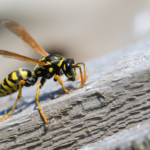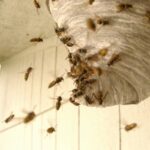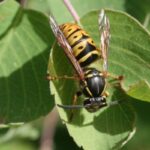 Yellow jacket species are smaller than other wasps but more aggressive. They’re more likely to sting than other wasps, but their stings hurt less. At a glance, wasps and yellow jackets look and behave very similarly. You’ll find the bright yellow and black insects in the backyard, at picnics and other outdoor activities.
Yellow jacket species are smaller than other wasps but more aggressive. They’re more likely to sting than other wasps, but their stings hurt less. At a glance, wasps and yellow jackets look and behave very similarly. You’ll find the bright yellow and black insects in the backyard, at picnics and other outdoor activities.
Yellowjacket nests are usually built underground, although some species will construct their nests in hollow logs, trees, attics, between walls, or under eaves of houses. An underground yellowjacket nest is difficult to locate because the entrance is about the size of a nickel.
 Most yellowjacket workers forage for food within 1,000 feet of their nest. In the middle of the season usually June through August yellowjackets are drawn to protein sources, such as hamburgers on the barbecue grill. During the late summer to early fall, they tend to shift their diet to sweets, including soda and juice.
Most yellowjacket workers forage for food within 1,000 feet of their nest. In the middle of the season usually June through August yellowjackets are drawn to protein sources, such as hamburgers on the barbecue grill. During the late summer to early fall, they tend to shift their diet to sweets, including soda and juice.
Yellowjackets are more aggressive than other stinging insects such as wasps, hornets, mud daubers or bees. Yellowjackets can both sting and bite — they will often bite to get a better grip to jab their stinger in. Since they don’t lose their stinger, they can sting numerous times, and will do so unprovoked. Yellowjackets can be mistaken for honeybees, yellowjackets are brighter in color, with a thinner, more defined waist.
If you experience problems with yellowjacket or any other type of bees or wasp, call the experts at Universal Pest Services (610)449-0740 and schedule a free inspection today!